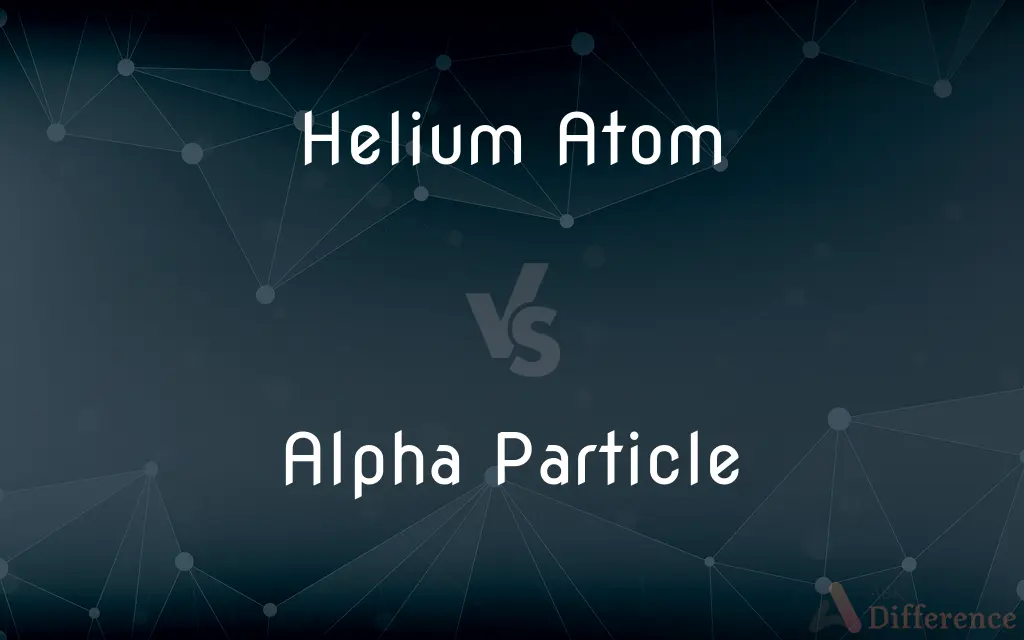Helium Atom vs. Alpha Particle — What's the Difference?
By Tayyaba Rehman — Published on October 17, 2023
A Helium Atom has 2 protons, 2 neutrons, and 2 electrons. An Alpha Particle consists of 2 protons and 2 neutrons but lacks electrons. Both are related, but a Helium Atom is electrically neutral while an Alpha Particle is positively charged.

Difference Between Helium Atom and Alpha Particle
Table of Contents
ADVERTISEMENT
Key Differences
Helium Atom: This is a stable atomic structure representing the chemical element helium. It is composed of 2 protons, 2 neutrons, and 2 electrons. The electrons orbit the nucleus, giving the Helium Atom its neutral charge. When we talk about helium in everyday contexts, such as the gas used to fill balloons, we're referring to collections of Helium Atoms.
Alpha Particle: This is a type of ionizing radiation ejected from certain radioactive materials. An Alpha Particle is made up of 2 protons and 2 neutrons, identical to the nucleus of a Helium Atom. However, the difference is that it lacks the electrons, giving the Alpha Particle a +2 charge. It's this positive charge that makes Alpha Particles less penetrating than other forms of radiation.
Helium Atom and Alpha Particle Comparison: When considering their structure, a Helium Atom and an Alpha Particle are almost twins, with the key difference being the two electrons present in the Helium Atom. This distinction plays a significant role in their interactions with other atoms and molecules.
Applications and Importance: Helium Atoms have a variety of applications, from cooling in MRI machines to inflating balloons. Alpha Particles, on the other hand, are used in smoke detectors and cancer treatments, despite being hazardous in large amounts.
Comparison Chart
Composition
2 protons, 2 neutrons, 2 electrons
2 protons, 2 neutrons
ADVERTISEMENT
Charge
Neutral
+2 Positive charge
Penetration Capability
N/A (not ionizing)
Low (stopped by paper or skin)
Origin
Natural element on periodic table
Emitted from radioactive decay
Typical Use
Cooling, inflating balloons
Smoke detectors, cancer therapy
Compare with Definitions
Helium Atom
An atom of the second element on the periodic table, consisting of two protons, two neutrons, and two electrons.
When cooled, the Helium Atom behaves in strange and quantum ways.
Alpha Particle
A particle used in various applications, including smoke detectors and cancer treatments.
The Alpha Particle is employed in specific therapies to target cancerous cells.
Helium Atom
A light atom that forms when hydrogen atoms fuse inside stars.
Our sun produces Helium Atoms through nuclear fusion.
Alpha Particle
A chunk of matter often associated with radioactive processes and nuclear reactions.
Studying the behavior of an Alpha Particle helps physicists understand nuclear physics.
Helium Atom
An atom with the atomic number 2, often used in industries and celebrations.
A Helium Atom remains unreactive under normal conditions.
Alpha Particle
A positively charged particle consisting of two protons and two neutrons.
The Alpha Particle is one of the particles emitted during radioactive decay.
Helium Atom
The basic unit of the element helium, recognized by its neutral charge.
The balloon rose because it was filled with Helium Atoms.
Alpha Particle
A type of ionizing radiation with limited penetration capability.
Despite its charge, an Alpha Particle can be stopped by a piece of paper.
Helium Atom
A gaseous atom that plays a crucial role in various scientific and medical applications.
The MRI machine requires the unique properties of the Helium Atom for cooling.
Alpha Particle
An emission from certain radioactive materials, identical in composition to a helium nucleus.
Radon gas decays by emitting an Alpha Particle.
Common Curiosities
Are Helium Atoms dangerous?
No, Helium Atoms are inert and non-toxic.
Can you see a Helium Atom with the naked eye?
No, atoms, including the Helium Atom, are too small to be seen without specialized equipment.
Why is an Alpha Particle positively charged?
Because it consists of 2 protons and 2 neutrons, but lacks electrons.
How is an Alpha Particle related to a Helium Atom?
An Alpha Particle has the same nuclear composition as a Helium Atom's nucleus but lacks electrons.
How can you protect yourself from Alpha Particles?
Alpha Particles can be stopped by materials as thin as paper or even human skin.
Are all Helium Atoms identical?
Yes, all Helium Atoms of the same isotope are identical in structure and properties.
Is the Alpha Particle heavier than other forms of radiation like beta particles?
Yes, an Alpha Particle, consisting of 2 protons and 2 neutrons, is heavier than a beta particle, which is an electron or positron.
What is a Helium Atom?
A Helium Atom is the basic unit of the element helium, consisting of 2 protons, 2 neutrons, and 2 electrons.
How do stars, like the Sun, produce Helium Atoms?
They fuse hydrogen atoms in nuclear reactions, producing Helium Atoms.
Why don't Helium Atoms easily combine with other atoms?
Because they are noble gases and have a full electron shell, making them stable and unreactive.
Where is the Helium Atom most commonly found on Earth?
In natural gas deposits, from which commercial helium is extracted.
Are Alpha Particles used in any everyday devices?
Yes, they're used in certain types of smoke detectors.
What is the primary source of Alpha Particles?
They are emitted from certain radioactive materials during decay.
What happens when a Helium Atom loses its electrons?
It becomes a positively charged ion, identical in composition to an Alpha Particle.
Can Alpha Particles harm the human body?
While they have low penetration, if ingested or inhaled, Alpha Particles can damage internal tissues.
Share Your Discovery

Previous Comparison
Buffalo Milk vs. Cow Milk
Next Comparison
Strong Entity vs. Weak EntityAuthor Spotlight
Written by
Tayyaba RehmanTayyaba Rehman is a distinguished writer, currently serving as a primary contributor to askdifference.com. As a researcher in semantics and etymology, Tayyaba's passion for the complexity of languages and their distinctions has found a perfect home on the platform. Tayyaba delves into the intricacies of language, distinguishing between commonly confused words and phrases, thereby providing clarity for readers worldwide.
















































